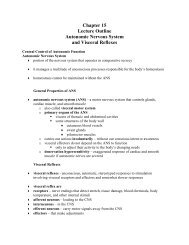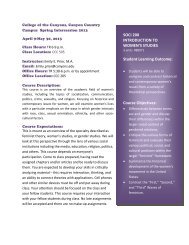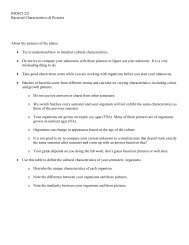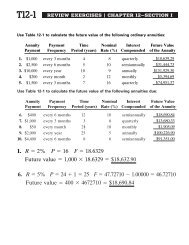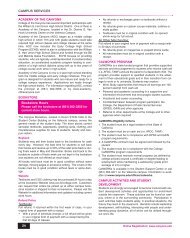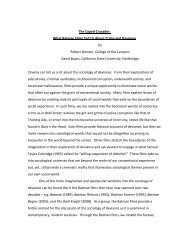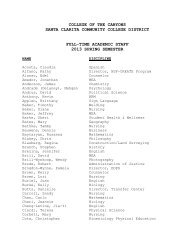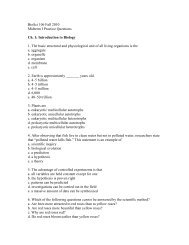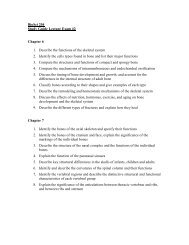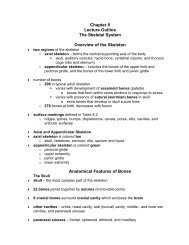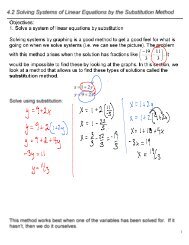Chapter 5
Chapter 5
Chapter 5
Create successful ePaper yourself
Turn your PDF publications into a flip-book with our unique Google optimized e-Paper software.
Ch 5.1 : More on verifying identities<br />
In this section, we prove (more) trig. identities.<br />
Theorem (Pythagorean identities)<br />
sin 2 t + cos 2 t = 1<br />
tan 2 t + 1 = sec 2 t<br />
1 + cot 2 t = csc 2 t<br />
Proof. Let (x, y) be a point on the Unit circle.
Verifying symmetry of sine, cosine, and tangent functions<br />
Theorem (Identities due to symmetry)<br />
sin(−t) = − sin(t)<br />
cos(−t) = cos(t)<br />
tan(−t) = − tan(t)<br />
Proof. Let (x, y) be a point on the Unit circle.
Example 1<br />
Prove that<br />
(1 − tan t) 2 = sec 2 (t) + 2 tan(−t)
Example 2<br />
Prove that<br />
sin 2 t · tan 2 t = tan 2 t − sin 2 t
Example 3<br />
Prove that<br />
cos t<br />
1 + sec t<br />
= 1 − cos t<br />
tan 2 t
Example 4<br />
Prove that<br />
sec x<br />
sin x<br />
sin x<br />
−<br />
sec x = tan2 x + cos2 x<br />
tan x
Class Exercises<br />
Verify the following identities.<br />
1−cos x sin x<br />
1. sin x = 1+cos x<br />
1 2. cos2 1 + x sin2 x = csc2 x sec2 x<br />
3.<br />
= csc x<br />
1+cos(−x)<br />
sin x−cos x sin(−x)
5.2: The Sum and Difference Identities<br />
Theorem<br />
sin(α ± β) = sin α cos β ± cos α sin β<br />
Note: ± ⇒ ±<br />
Examples:<br />
◮ sin( π<br />
4<br />
◮ sin( π<br />
4<br />
◮ sin( 5π<br />
12<br />
+ π<br />
6<br />
− π<br />
6<br />
) =<br />
◮ sin(− π<br />
12<br />
) = sin( π<br />
4<br />
) =<br />
) =<br />
) cos( π<br />
6<br />
) + cos( π<br />
4<br />
π ) sin( 6 ) =
5.2: The Sum and Difference Identities<br />
Theorem<br />
cos(α ± β) = cos α cos β ∓ sin α sin β<br />
Note: ± ⇒ ∓<br />
Examples:<br />
◮ cos( π<br />
4<br />
◮ cos( π<br />
4<br />
◮ cos( 5π<br />
12<br />
◮ cos( π<br />
12<br />
+ π<br />
6<br />
− π<br />
6<br />
) =<br />
) =<br />
) = cos( π<br />
4<br />
) =<br />
) cos( π<br />
6<br />
) − sin( π<br />
4<br />
π ) sin( 6 ) =
Cofunction identities<br />
Theorem (The Cofunction Identities)<br />
cos( π<br />
− t) = sin t, sin(π − t) = cos t<br />
2 2<br />
Example) Using the cofunction identities, verify that<br />
cos( π π<br />
6 ) = sin( 3 ).<br />
Proof(s) of theorem.
Sum and difference identities for Tangent<br />
Theorem<br />
Example) tan( π<br />
12 ) =<br />
Proof of theorem:<br />
tan(α ± β) =<br />
tan α ± tan β<br />
1 ∓ tan α tan β
Example 3<br />
Given sin α = 5<br />
13 with the terminal side in the 1st quadrant, and<br />
tan β = − 24<br />
7 with the terminal side in the 2nd quadrant, compute<br />
the value of cos(α + β).
Example 4<br />
Use the sum or difference identity for tangent to find the exact<br />
value of tan 11π<br />
12 .
Example 6<br />
Prove that<br />
sin(α + β) sin(α − β) = sin 2 α − sin 2 β
Class Exercise<br />
Given α and β are acute angles, with cos α = 8<br />
find<br />
1. sin(α + β)<br />
2. cos(α − β)<br />
3. tan(α + β)<br />
17<br />
and sec β = 25<br />
7 ,
Ch 5.3 : The Double-Angle and Half-Angle Identities<br />
Theorem (The Double-Angle Identities)<br />
◮ cos(2α) = cos 2 α − sin 2 α = 1 − 2 sin 2 α = 2 cos 2 α − 1<br />
◮ sin(2α) = 2 sin α cos α<br />
◮ tan(2α) =<br />
2 tan α<br />
1−tan 2 α<br />
Let’s verify these identities.
Example 2 : Combining sum and double-angle identities<br />
Prove that<br />
Proof:<br />
cos 3θ = 4 cos 3 θ − 3 cos θ
Example 3 : Using double-angle identity<br />
Find the exact value of sin π π<br />
8 cos 8 .
The power reduction identities<br />
Theorem<br />
cos 2 α = 1+cos(2α)<br />
2 , sin 2 α = 1−cos(2α)<br />
2 , tan 2 α = 1−cos(2α)<br />
1+cos(2α)<br />
Proof.
Example 4<br />
Prove that<br />
8 sin 4 x = 3 − 4 cos(2x) + cos(4x)
Half-Angle Identities<br />
Theorem<br />
◮ cos( u<br />
2<br />
◮ sin( u<br />
2<br />
<br />
1+cos u<br />
) = ±<br />
2<br />
<br />
1−cos u<br />
) = ± 2<br />
◮ tan( u<br />
<br />
1−cos u<br />
2 ) = ± 1+cos u<br />
Proof.<br />
= 1−cos u<br />
sin u<br />
= sin u<br />
1+cos u
Example 5<br />
Use the half-angle identities to find exact values for a) sin π<br />
12 and<br />
b) tan π<br />
12 .
Example 6<br />
For cos θ = − 7<br />
25<br />
sin θ<br />
2<br />
and b) cos θ<br />
2 .<br />
, and θ in the 3rd quadrant, find exact values of a)
Ch 5.4 : The Product-to-Sum Identities<br />
Proof.<br />
cos α cos β = 1<br />
[cos(α + β) + cos(α − β)]<br />
2<br />
sin α sin β = 1<br />
[cos(α − β) − cos(α + β)]<br />
2
The Product-to-Sum Identities<br />
Proof.<br />
sin α cos β = 1<br />
[sin(α + β) + sin(α − β)]<br />
2<br />
cos α sin β = 1<br />
[sin(α + β) − sin(α − β)]<br />
2
Example<br />
Rewrite the following product as a sum using the product-to-sum<br />
identities.<br />
2 sin(3x + y) cos(3x − y)
The Sum-to-Product Identities (for cosines)<br />
Proof.<br />
<br />
u + v u − v<br />
cos u + cos v = 2 cos cos<br />
2<br />
2<br />
<br />
u + v u − v<br />
cos u − cos v = −2 sin sin<br />
2<br />
2
The Sum-to-Product Identities (for sines)<br />
Proof.<br />
<br />
u + v u − v<br />
sin u + sin v = 2 sin cos<br />
2<br />
2<br />
<br />
u + v u − v<br />
sin u − sin v = 2 cos sin<br />
2<br />
2
Example<br />
Write the sum as a product using a sum-to-product identity.<br />
sin(14k) + sin(41k)
Class Exercise<br />
Verify the following identity.<br />
<br />
sin(m) + sin(n) m + n<br />
= tan<br />
cos(m) + cos(n) 2




